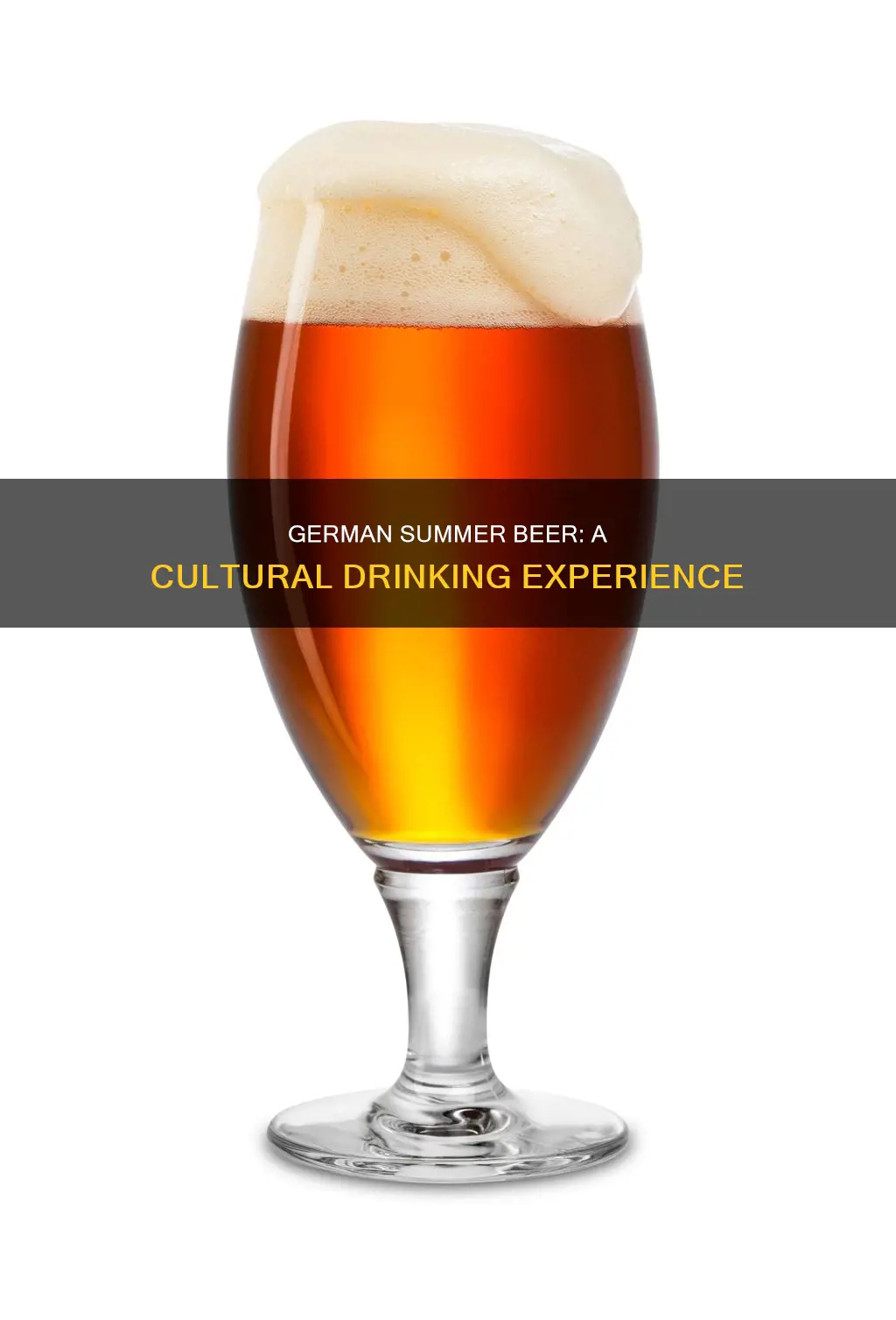
Germany is known for its beer, and Germans drink a lot of it—95 litres per person in 2020, to be precise. With over 7,000 varieties of beer in Germany, there's plenty to choose from. But what do Germans drink in the summer?
Well, one popular choice is Helles Lager. This Bavarian beer dates back to the late 1800s and is known for its light colour and careful balance of rich maltiness and noble hops. Another summer favourite is Weizen (wheat) beer, or Hefeweizen (yeast-wheat). These beers are typically brewed with more than 50% malted wheat and have sweet aromas and notes of citrus. They're often served in tall, slender glasses in German beer gardens during the summer.
Pilseners are also a popular choice for German summer drinking. This style of beer was first invented in the Czech city of Pilsen in the 1840s but was later replicated in Germany. Pilseners are characterised by their blonde, clear appearance and the prominent flavour of hops.
| Characteristics | Values |
|---|---|
| Country | Germany |
| Number of beer varieties | Over 7,000 |
| Number of breweries | 1,300 |
| Region with the most breweries | Southern region of Bavaria |
| Beer served with | Meals or pretzels |
| Beer served in | Beer halls or intimate pubs |
| Beer types | Pilsner, Helles or Dunkles Lager, Export Lager, Kölsch, Alt, Weißbier, Starkbier or Bockbier, Berliner Weisse, Märzen or Oktoberfestbier, Gose, Zwickl, Rauchbier, Radler or Alsterwasser, Alcohol-free beer, Malzbier |
| Beer ingredients | Barley, malt, hops, water, yeast |
| Beer colour | Light, dark |
| Beer taste | Bitter, fruity, zesty, refreshing, sweet, malty, nutty, bitter chocolate, banana, clove, coriander, citrus, cinnamon, nutmeg, bubblegum, caramel, chocolate, fig, spicy |
| Beer glass | Long neck pilsner glass, stein, large glass, tall slender glass, cylindrical narrow glass, wide-bodied glass, chalice-type glass |
| Beer ABV | 4.0% - 8% |
| Beer temperature | 38°F, 50-55°F, 8°C |
What You'll Learn

Hefeweizen
The aroma and flavour of Hefeweizen come largely from the yeast and are characterised by fruity (particularly banana) and phenolic (clove) notes. Other flavour notes include bubblegum, apples, and sometimes vanilla. The intensity of these flavour qualities varies depending on the brewer, but the two are most commonly balanced.
Shaking Bottled Beer: Good or Bad Idea?
You may want to see also

Helles Lager
Helles is a bottom-fermented beer with more pronounced malt notes. It comes in light or dark colours depending on the degree to which the malt was roasted. It is less bitter than other beers, with about 4.5% alcohol. Well-known brands include Löwenbräu, Hofbräu, and Dortmunder Aktienbrau (DAB).
Helles is a malt-accented lager beer that balances a pleasant malt sweetness and body with floral Noble hops and restrained bitterness. The malt character is soft and bready, making it a terrific complement to light dishes such as salad or fresh shellfish, like clams. Clean and crisp, this is a refreshing beer with substance.
Helles is highly versatile for pairing with food, but it is designed for refreshment and makes for the ideal beer on a hot day. Small and independent craft brewers offer their own takes on this classic German beer, with some following the German tradition exactly, and others adding their own American twist.
Beer and Sore Throats: Relief or Risk?
You may want to see also

Alcohol-free beer
There are many alcohol-free German beers to choose from, including:
- Krombacher Pilsener
- Schneider Tap Weizen
- Paulaner Weizen
- Warsteiner
- Franziskaner
- Erdinger
- Bitburger
- Weihenstephaner
- Clausthaler
- Becks Blue
- Maisel's Weisse
High Blood Pressure and Beer: Is It Safe?
You may want to see also

Pilsener
Pilsner, or pilsener, is a type of pale lager that is very popular in Germany. It was first produced in 1842 in the city of Pilsen, Bohemia (now in the Czech Republic). The beer was created by Bavarian brewer Josef Groll, who used local ingredients to produce a clear, golden beer.
Pilsner is characterised by its light colour and short finish. German pilsners tend to be less malty and more bitter than their Bohemian counterparts, with a more hop-forward flavour profile. This is due to the high sulfate content in the water used to brew the beer. German pilsners typically use 100% German pilsner malt, which gives the beer a slight sweetness that accents the bitterness and makes it more drinkable.
The crisp, dry, and herbal-bitter taste of pilsner makes it a refreshing choice for summer drinking. It pairs well with shellfish, chicken, and salads. Pilsner has an alcohol content of around 4.5% to 5%, and is best served at a temperature of 50°F/10°C.
Some well-known brands of German pilsner include Beck's, Bitburger, Krombacher, and Radeberger.
Mixing Vyvanse and Beer: Is It Safe?
You may want to see also

Wheat beer
Weissbier comes in three varieties: Kristall (clear and filtered), Hefe (cloudy and yellow with some wheat and yeast residue), and Dunkel (made with roasted dark malt). Munich insiders recommend Schneider Weisse or Augustiner Weisse.
The Hefeweizen style of wheat beer is typically brewed with more than 50% malted wheat and features sweet aromas and notes of citrus. They are orange in appearance and can feature a wide range of fruity and spicy notes, from citrus to banana to coriander.
When it comes to German-style brewing, wheat beer is one of the best summer beer types. Visit any German beer garden in the summer and you’re likely to find tall glasses of Hefeweizen being served.
Kayaking and Beer: Is It Legal to Drink?
You may want to see also
Frequently asked questions
Popular beers in Germany during the summer include Helles Lager, Hefeweizen, and Pilsener.
Helles Lager is a Bavarian-style beer that dates back to the late 1800s. It is known for its light colour and carefully balanced rich maltiness with noble hops.
Hefeweizen is a wheat beer or yeast-wheat beer that is typically brewed with more than 50% malted wheat. It generally features sweet aromas and notes of citrus.
Pilsener is one of the world's most popular beer styles, known for its blonde, clear appearance, prevalent hops, and bitter bite.
Yes, alcohol-free beer is also popular in Germany during the summer. It is refreshing after sports and can be surprisingly hydrating. It contains vitamins, fibre, and fewer calories than regular beer.
Yes, some other summer drinks that are popular in Germany include Hugo, Aperol Spritz, and the Munich Mule.







